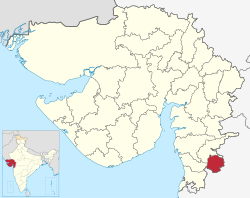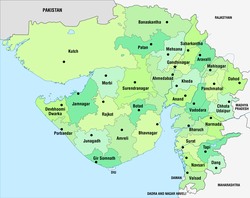Dang district, India
 From Wikipedia - Reading time: 13 min
From Wikipedia - Reading time: 13 min
Dang District
Dandakaranya | |
|---|---|
 Lakes near Saputara | |
 Location of Dang district in Gujarat | |
| Coordinates: 20°45′31.7″N 73°41′19.0″E / 20.758806°N 73.688611°E | |
| Country | |
| State | Gujarat |
| Headquarters | Ahwa |
| Area | |
• Total | 1,764 km2 (681 sq mi) |
| Population (2011) | |
• Total | 228,291 |
| • Density | 130/km2 (340/sq mi) |
| Languages | |
| • Official | Gujarati, Hindi, English |
| • Spoken | Khandeshi, Gujarati, Bhili, Marathi, Hindi |
| Time zone | UTC+5:30 (IST) |
| Vehicle registration | GJ-30 |
| Website | dangs |
Dang is a district in the southeastern part of the state of Gujarat. The administrative headquarters of the district are located in Ahwa. Dang has an area of 1,764 km2 and a population of 228,291 (as of 2011).[1] As of 2011, it is the least populous of Gujarat's 33 districts.[2] As per the Planning Commission, Dang is one of the most economically distressed districts out of 640 districts in India.[3][4] 94% of the population belongs to one of the scheduled tribes.[5][6] The five Kings of Dangs are the only hereditary royals in India whose titles are currently recognized by the government owing to an agreement between the East India Company and the Dang kings in 1842.[7][8]
Etymology
[edit]The origin of the name of the Dang is uncertain. In common parlance the word 'dang' means a hilly village. There is another connotation of the word 'dang' which means bamboo (a place of bamboo). The name is also associated with Hindu mythology. It is related to the Dandakaranya of the Ramayana. It is said that during the exile, Rama passed through this area on his way to Nashik.[9]
Kings of Dang
[edit]
The five Royal Bhil Kings of Dangs are currently the only hereditary rulers in India.[10]
Before Independence several wars were fought between the five tribal kings of Dang and the Company. According to the history of Dang, the biggest war to took place at 'Lashkaria Amba', in when the kings of all the five states joined to protect Dang from the British.[7] The British were beaten and agreed to a compromise.[7]
As per the treaty signed in 1842 the Company allowed to use the forests and their natural products against which they had to pay around 3,000 silver coins to the five kings. Currently the kings receive a yearly political pension by the Government of India, which is the main source of their income. This payment is continued even though all privy purses for the Princely states of India were stopped in 1970 since the agreement was between then monarchy of Dangs and the Government of India, not the Crown.[7][11]
At the end of each fiscal year during Holi, the kings gather in Ahwa for a traditional royal ceremony, in their richly decorated buggies and bands with tribal dancers, to receive the payment as per the agreement of 1842.[12] In ancient Indian Scriptures Dang is known as Danda Aranyaka, meaning 'Bamboo forest'.[11] Recently the Dangs Kings have urged the government to protect their depleting forest cover due to illegal logging.[13]
The five kingdoms are Daher-Amala, Linga, Gadhvi, Vasurna and Pimpri.[7][14]
Rulers
[edit]- Linga - Raja Bhawarsinh
- Daher-Amala - Raja Tapatrao Anandrao Pawar
- Gadhvi - Raja Karan Singh Yashwantrao Pawar
- Vasurna - Raja Dhanrajsinh Chandrasinh Suryavanshi
- Pimpri - Raja Trikamrao Sahebrao Pawar
Dang States
[edit]Historically there were 14 Dang states in the region: [15]
- Amala
- Avchar
- Bilbari
- Chinchli Gaded
- Derbhavti
- Gadvi
- Jhari Gharkhadi
- Kirli
- Palasvihir
- Pimpladevi
- Pimpri
- Shivbara
- Vadhyawan
- Vasurna
Demographics
[edit]| Year | Pop. | ±% p.a. |
|---|---|---|
| 1901 | 18,333 | — |
| 1911 | 28,926 | +4.67% |
| 1921 | 24,142 | −1.79% |
| 1931 | 33,495 | +3.33% |
| 1941 | 40,236 | +1.85% |
| 1951 | 47,282 | +1.63% |
| 1961 | 71,567 | +4.23% |
| 1971 | 94,185 | +2.78% |
| 1981 | 113,664 | +1.90% |
| 1991 | 144,091 | +2.40% |
| 2001 | 186,729 | +2.63% |
| 2011 | 228,291 | +2.03% |
| source:[16] | ||
According to the 2011 census, Dang district has a population of 228,291,[2] roughly equal to the nation of Vanuatu.[18] This gives it a ranking of 587th in India (out of a total of 640).[2] The district has a population density of 129 inhabitants per square kilometre (330/sq mi).[2] Its population growth rate over the decade 2001-2011 was 21.44%.[2] Dang has a sex ratio of 1007 females for every 1000 males,[2] and literacy rate of 76.8%. 10.81% of the population lives in urban areas. Scheduled Castes and Scheduled Tribes make up 0.43% and 94.65% of the population respectively.[2]
Language
[edit]At the time of the 2011 Census of India, 59.55% of the population in the district spoke Dangi, 32.53% Gujarati, 3.18% Gamit, 1.99% Marathi and 1.21% Hindi as their first language.[19]
Politics
[edit]| District | No. | Constituency | Name | Party | Remarks | |
|---|---|---|---|---|---|---|
| Dang | 173 | Dangs (ST) | Vijaybhai Patel | Bharatiya Janata Party | ||
Economy
[edit]In 2006 the Ministry of Panchayati Raj named Dang District as an economically distressed district, one of 250 out of a total of 640 districts.[20] It is one of the six districts in Gujarat currently receiving funds from the Backward Regions Grant Fund Programme (BRGF).[20]
Forest
[edit]Dang District has part of a forest that includes Purna Wildlife Sanctuary,[21] which is shared between the districts of Dang and Tapi in Gujarat and Nandurbar District in Maharashtra,[22][23] and Vansda National Park in Navsari District, which shares a continuous tract of forest with Valsad district.[21][24][better source needed]
A rusty-spotted cat was sighted for the time in 1991 in Shoolpaneshwar Wildlife Sanctuary.[25]
In Purna and Ratanmahal Wildlife Sanctuaries, eight bird species are considered locally extinct, including Indian grey hornbill, jungle bush quail, red spurfowl and large woodshrike.[21] Also, Bengal tiger, Indian giant squirrel and gaur are reportedly extinct in Gujarat.[26]
Talukas
[edit]Rivers of district
[edit]See also
[edit]Places of interest
[edit]- Botanic Garden, Waghai - Large Government Ayurvedic Medicinal Garden (Botanical Garden) near Waghai[27]
- Gira Falls on Ambika River near Waghai
- Hill stations: Saputara and Don
- Gira Falls on Gira River at Girmal village
- Rupgadh Fort
- Shabri Dham and Pampa Sarovar at Subir
References
[edit]- ^ "Census GIS India". Archived from the original on 2007-07-03. Retrieved 2009-08-27.
- ^ a b c d e f g "District Census Hand Book – Dangs" (PDF). Census of India. Registrar General and Census Commissioner of India.
- ^ "Governance in Gujarat Under Modi - A Critique"
- ^ "In Gujarat's Dangs District, Tribals Are Left With No Option but to Migrate For Survival". News18. 5 April 2019. Retrieved 21 October 2022.
- ^ "About Dang".
- ^ "Konkanian Origin of the 'East Indians'".
- ^ a b c d e Mehta, Yagnesh Bharat. "Dangs darbar gets off to royal start". The Times of India. Archived from the original on 2018-08-16. Retrieved 2021-12-28.
- ^ "DNA India | Latest News, Live Breaking News on India, Politics, World, Business, Sports, Bollywood". DNA India. Retrieved 2021-12-28.
- ^ G. D. Patel, ed. (1971). Gazetteer of India: Dangs District. Ahmedabad: Directorate of Government Print., Stationery and Publications. pp. 1–2.
- ^ Kings of the Dang
- ^ a b Andrabi, Jalees (13 March 2009). "Once a year, peasant rulers are given the royal treatment". The National. Archived from the original on 15 January 2013. Retrieved 19 April 2010.
- ^ Chandra, Kavita Kanan (2017-06-24). "Kings of the Dang". The Hindu. ISSN 0971-751X. Retrieved 2021-12-28.
- ^ Dang tribal kings urge Modi to protect their jungle
- ^ "Kings hold durbar at Dangs, but at Govt expense". Indian Express Newspapers. 28 February 1999. Retrieved 19 April 2010.
- ^ "The golden book of India; a genealogical and biographical dictionary of the ruling princes, chiefs, nobles, and other personages, titled or decorated, of the Indian empire, with an appendix for Ceylon", https://archive.org/details/goldenbookofindi00lethrich/page/40/mode/2up
- ^ Decadal Variation In Population Since 1901
- ^ "Population by Religion - Gujarat". censusindia.gov.in. Registrar General and Census Commissioner of India. 2011.
- ^ US Directorate of Intelligence. "Country Comparison:Population". Archived from the original on June 13, 2007. Retrieved 2011-10-01.
Vanuatu 224,564 July 2011 est.
- ^ "Table C-16 Population by Mother Tongue: Gujarat". censusindia.gov.in. Registrar General and Census Commissioner of India.
- ^ a b Ministry of Panchayati Raj (September 8, 2009). "A Note on the Backward Regions Grant Fund Programme" (PDF). National Institute of Rural Development. Archived from the original (PDF) on April 5, 2012. Retrieved September 27, 2011.
- ^ a b c Trivedi, P. and Soni, V.C. (2006). "Significant bird records and local extinctions in Purna and Ratanmahal wildlife sanctuaries, Gujarat, India" (PDF). Forktail. 22: 39–48.
{{cite journal}}: CS1 maint: multiple names: authors list (link) - ^ "Mahal Eco Campsite". Gujarat Tourism. Archived from the original on 2017-02-02. Retrieved 2017-01-25.
- ^ Jhala, Y. V., Qureshi, Q., Sinha, P. R. (Eds.) (2011). Status of tigers, co-predators and prey in India, 2010. National Tiger Conservation Authority, Govt. of India, New Delhi, and Wildlife Institute of India, Dehradun. TR 2011/003 pp-302
- ^ "Vansda National Park". Gujarat Tourism. Archived from the original on 2016-12-09. Retrieved 2017-01-29.
- ^ Chavan, S.A.; Patel, C. D.; Pawar, S. V.; Gogate, N. S.; Pandya, N. P. (1991). "Sighting of the rusty-spotted cat Felis rubiginosa (Geoffroy) in Shoolpaneshwar Sanctuary, Gujarat". Journal of the Bombay Natural History Society (88): 107−108.
- ^ Worah, S. (1991). The ecology and management of a fragmented forest in south Gujarat, India: the Dangs. Ph.D. thesis, University of Poona, Pune, India.
- ^ "Waghai Botanical Gardens". gujrattourism. Retrieved 2023-03-17.
External links
[edit]- Official website

- Dang District Panchayat-Official web
- Are there tigers in the Dangs?
 Geographic data related to Dang district, India at OpenStreetMap
Geographic data related to Dang district, India at OpenStreetMap
 KSF
KSF
